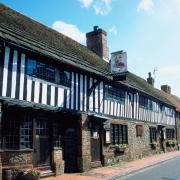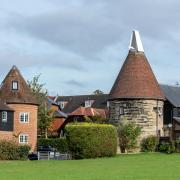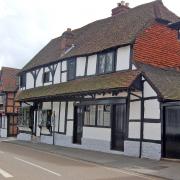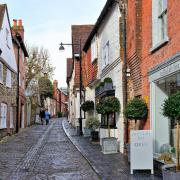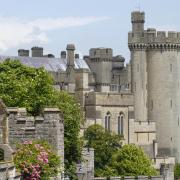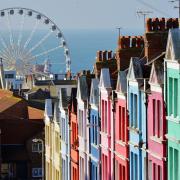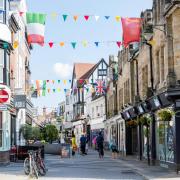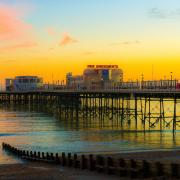Not everything is what it seems in the West Sussex town of Petworth as we discover
Street names matter to Peter Jerrome and, as he shuts the front door on Trowels in Pound Street, he explains the street is so named because there was a cattle pound down the road back in the days when Petworth was a bustling market town.
We stroll uphill in the summer sunshine, and I get the feeling that Peter, who has lived here for many years and is chairman of the Petworth Society, loves the town and is a popular figure around these parts. He stops several times for a brief chat with fellow residents before we eventually arrive in Golden Square. “It used to be Beast Market but was then re-named after Golden Square in London,” he explains. Apparently the beasts were mostly pigs and so maybe someone in authority thought it needed rebranding.
Leconfield Hall is a fine stone building overlooking the square. There is a bust of William of Orange halfway up one wall which I admire as Peter dashes off to fetch a key that will let us in. Built at the end of the 18th century, Leconfield Hall fell into disrepair and was mercifully restored in the 1990s with the help of lottery funding and a significant contribution from the estate of the late Gwenda Morgan, a former local resident and renowned wood engraver.
With a large auditorium, the hall is now used for a rich variety of events including the society’s famous book sale, held on the second Saturday of every month. Curiously, there’s a Canadian flag hanging on a wall. This same flag previously flew above the Canadian Parliament building in Ottawa and was presented to the Petworth Society by the Toronto Scottish Regiment, which was stationed near here during World War II and forged a close relationship with the town that continued long after hostilities ceased.
The war witnessed the blackest day in Petworth’s long history. On September 29 1942 a lone German Heinkel 111 dropped a bomb that landed on the Boys’ School in North Street, killing 28 pupils, Charles Stevenson (the headmaster) and Charlotte Marshall (an assistant teacher). Last year, on the 75th anniversary of the tragedy, the Petworth Society produced a special commemorative issue of their quarterly magazine devoted to observations, recollections and thoughts on that dreadful day.
To lighten the now sombre mood, Peter tells me that Petworth claims to hold the oldest street fair in the south of England. It takes place in front of Leconfield Hall and might be the coldest as well as the oldest as, unless it’s a Sunday, it’s always staged on November 20, the Feast of St Edmund the King. “It dates from 1273 at least,” claims Peter. “Or possibly 1199… or maybe even further back than that.”
We turn up Lombard Street which, seemingly inevitably, has changed its name, this time from The Causey. Once again, apparently, London is the source of inspiration behind the new name. “This street was once the engine room of the town,” comments Peter. The road is cobbled and lined with the sort of chic shops that are very much a feature of Petworth today. Peter points to one on the left that used to be studio of famous photographer, Walter Kevis, who died in 1924. More recently, Petworth has produced another renowned photographer, George Garland who, when he died in 1978, left behind more than 70,000 negatives.
At the top of Lombard Street, St Mary’s Church confronts us and Petworth House is to our left. Not including Petworth House in this saunter around town might seem odd but we are principally interested in ‘Secret Sussex’ and there’s nothing very secretive about this impressive National Trust property, its magnificent art collection or splendid park. And so we turn right and wander along Barton Lane. What can you guess about Barton Lane? Another nominal alteration? Well, you’re partially right but it’s not so much a change of name as a modest abbreviation as it used to be Bartons Lane and is still popularly so-called. Why the change? No one seems to know. There’s a curious old sign warning people not to throw stones at windows or lampposts and offering a five shilling reward to anyone reporting such antisocial behaviour. We enter a small graveyard which is no longer welcoming any more ‘residents’. “It was consecrated on 21 October, 1805,” Peter reveals. “Which was…” I’ve absolutely no idea. “The Battle of Trafalgar.”
We continue along a footpath with a delightful view over the glorious undulating countryside. Peter indicates terracing on the opposite hillside that is a relic of medieval farming practice. He then points to a couple of parallel paths across a field; one straight up a steep scarp, the other allowing a loaded wain to make the ascent. Peter tells of an unfortunate incident in the 1620s when a couple of dodgy workers in the employ of the Earl of Northumberland hid uncooled charcoal in the rector’s barn, which burnt down. History, it seems, is never far away in 21st century Petworth. The consequent acrimonious exchanges between the rector and the Earl resulted in the former withdrawing permission for the latter to use the path.
We pass the Sacred Heart Roman Catholic church that dates from the end of the 19th century and then a row of cottages that house Lord Leconfield’s estate workers. His Lordship’s property can readily be identified by the light brown front doors, which is the colour of the Leconfield livery.
Peter rather excitedly beckons me over to inspect a rather unprepossessing wall alongside a comparatively modern housing development. “What do you think they are?” he asks, pointing to some rather crude-looking letters scratched in the brickwork. Once again I fail to provide an answer but am delighted to learn that the bricks were taken from the solitary confinement cells when Petworth’s House of Correction was demolished in 1881. In the time-honoured way, prisoners scratched their names, initials and dates to help while away time in what was a notoriously austere institution. From the early 1820s to the late 1830s the governor was John Manse, who was renowned for his severe treatment of prisoners. A religious man, his deliberate intention was to make prison life so miserable that any released inmate would not do anything to risk re-incarceration.
On an altogether cheerier note, we wander around Mrs Cummings’s Cottage, which is a faithful re-creation of a worker’s home in about 1910 that can be found at Back Street… er, I mean, High Street. Yes, the name was changed. Mrs Cummings worked as a seamstress at Petworth House and her former home is filled with all sorts of wondrously nostalgic stuff. There’s a coal-fired range for cooking and heating in the living-room and Peter asks me if I can guess what an AGA-like device in the kitchen is. I think I can be forgiven for failing to identify what must be one of the oldest washing machines in the world. Although it comes complete with a solid-fuel, water-heating facility it, unsurprisingly, doesn’t spin. But there’s a heavyweight mangle outside the back door that takes care of that.
Peter stresses that the town needs to be receptive to new ideas but must never lose sight of the long history that has moulded it. “Petworth must never lose the feeling that it is unique,” he remarks.
At the end of our pleasant stroll, Peter generously gives me a copy of his scholarly book Petworth From the Beginnings to 1660.
I read the opening chapter in the hope of finding evidence of the town’s serial name-changes but am disappointed to discover that it would appear to have always been Petworth, which is surprising.
For more information about the Petworth Society visit www.petworthsociety.co.uk
More…
• We went to find out more on the history of Rottingdean - Contraband goods provided a valuable source of income for Rottingdean in years past, and a number of illustrious figures have made it their home since then as Clive Agran discovers










